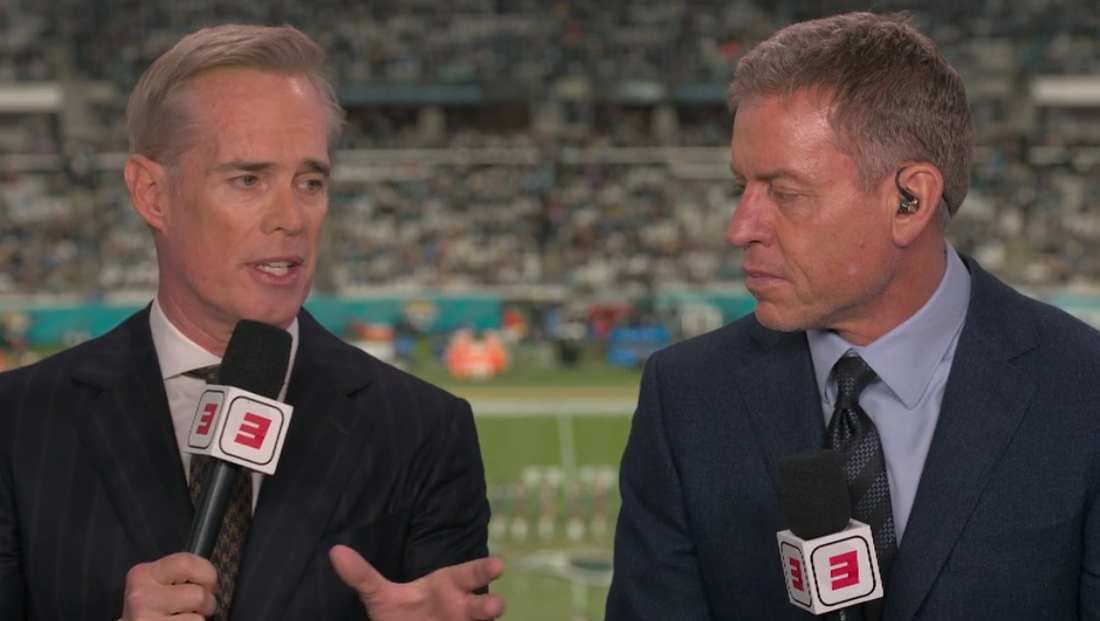ESPN transforms part of its logo into Hamlin tribute

Subscribe to NCS for the latest news, project case studies and product announcements in broadcast technology, creative design and engineering delivered to your inbox.
ESPN’s broadcast of the Tennessee Titans v. Jacksonville Jaguars Sunday, Jan. 8, 2023, was full of subtle and not-so-subtle Buffalo Bills player Damar Hamlin, who remains in the hospital after suffering cardiac arrest during a “Monday Night Football” broadcast Jan. 2, 2023.
Hamlin wears the number 3, so many of the tributes played homage to that — and sports broadcast giant ESPN found a clever way to turn its mic flags into a “3” — just by turning them upside down.
Normally ESPN commentators hold microphones with white cubed mic flags with a red “E” on them surrounded by a black border, which is obviously short for “ESPN.”
It is possible to buy rectangular microphone flags that would likely fit the entire horizontal ESPN logo.
These are often three-sided and can be larger and clunkier, so ESPN appears to have opted to just use the first letter of its name on this mic flag design — a look that it also uses for an app icon or avatar on digital platforms.
However, some at ESPN apparently had the clever idea to flip all the flags upside down, making that “E” become a “3” to honor Hamlin and send good vibes his way.
Throughout the broadcast, fans were also shown holding tribute signs to Hamlin and at least on of the “3”s in one of the 30-yard markers was outlined in red.

Sideline staffers were also seen sporting T-shirts paying homage to Hamlin.
What is a mic flag?
Mic flags are seen across TV news and sports all the time.
One of the most common places to see a lot together is during a press conference — when both TV and radio stations in attendance place their own microphones in front of the presenter’s location on what’s often called a mic tree. These can hold anywhere from a few to dozens of microphones and have the advantage of letting each station record audio from whoever is speaking separately.
Other press conferences, typically ones held in briefing rooms that are pre-wired for that type of event, may only have one (along with, in some cases, a backup) microphone in front of the speaker but provide all stations access to the audio either through a digital feed or allowing them to plug a cable into a panel that allows them to capture the audio.
Mic flags also often appear in field interviews and live reports — either with it being held in front of the person being interviewed or in the hands of the reporter themselves.
They have the advantage of letting stations place their logo or branding on-camera in yet another way. In the case of press events or when more than one station is interviewing the same person it also, in an odd twist of fate, often means that one or more competing stations’ logos appear on the other stations’ air.
Mic flags are typically made of hard, high-impact plastic. They can be cubes with logos printed on four sides (sometimes with different imagery on all or some of the sides). Other ones look like triangles behind viewed from above and have three faces. For stations with round or logos that have a distinct shape, it’s also possible to order ones in custom shapes that match the logo’s footprint. These can be three or four sided.
Mic flags typically work by simply inserting the lower part of a microphone through two designated holes in the plastic, usually on the top and bottom.
An interesting thing happens with mic flags when a network news service reporter or single reporter from a station group are dispatched to a story to provide live or taped reports for multiple stations. In many cases, these crews will travel with a mic flag from every station that it expects to provide a report for.
These are set within easy reach of the reporter (often on the floor or ground) and the reporter grabs the correct one for the station that is about to show a live report and puts it on the mic. Then, that one is put aside and replaced with one for the next station in line, and so on.
Subscribe to NCS for the latest news, project case studies and product announcements in broadcast technology, creative design and engineering delivered to your inbox.




tags
ESPN, mic flag, monday night football, NFL
categories
Broadcast Industry News, Featured, Sports Broadcasting & Production